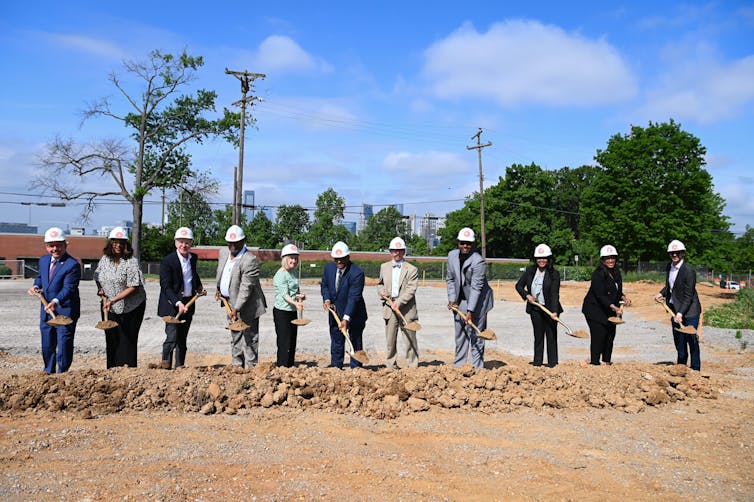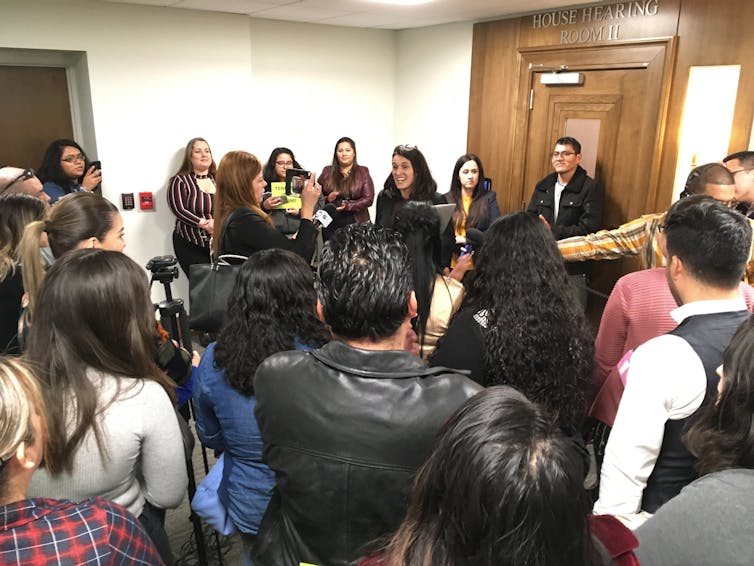
By Madhuri Sharma and Mikhail Samarin
Rents across the U.S. have climbed to staggering levels in recent years. Millions of renters spend more than 30% of their income on rent and utilities, a situation that housing experts call being cost burdened.
High rents affect almost all segments of the population but are an especially heavy burden for immigrants, particularly those who have not yet become U.S. citizens. Immigrants, both documented and undocumented, play important roles in the U.S. economy. They often provide the cheapest labor in the riskiest of industries. Yet they are still not broadly accepted or supported in many U.S. cities.
We are geographers who study housing market issues, including racial-ethnic diversity and housing affordability. Our research on Nashville, which has emerged as an immigrant metropolis in the Southern U.S., suggests that foreign-born residents who are not yet citizens are far more burdened by high rents than other groups.
Many immigrant workers in Nashville spend more than 50% of their incomes on rent. This makes it hard for them to afford education and job training, healthy food, health care and other necessities that can help them participate as productive residents. Heavy rent burdens undermine their ability to have a higher standard of living and to be included in mainstream society.
As immigrants increasingly fan out across the U.S., we believe cities receiving new foreign-born residents should anticipate a growing need for affordable housing.
Hard times for renters
The past 15 years have been challenging for renters across the country. In the 2008-09 recession, which was triggered by a collapse in the housing market, millions lost their homes to foreclosure and became renters. Tighter financing made it harder for others to buy homes. By 2015, almost 43 million households had been pushed into renting.
Today about 37% of U.S. homes are occupied by renters. By 2020, almost 46% of U.S. renters paid more than 30% of their household income toward rent. As of June 2021, the median monthly rent in the 50 largest U.S. cities was $1,575 – an 8.1% increase from June 2020.
The heaviest rent burdens fall disproportionately on minorities. Almost 46% of African American-led renter households are rent burdened, compared with 34% of white households.
The COVID-19 pandemic worsened housing insecurity for people of color because of longstanding racially targeted policies and widespread health and economic disparities. Renters of color faced higher cost burdens and eviction rates. In Nashville, this was especially true in Latino and Somali communities.
Why immigrant housing matters
Immigration is the main driver of population growth in the U.S., which is important for filling jobs and boosting tax revenues. After dipping because of pandemic-era restrictions in 2020-22, immigration to the U.S. started growing again, adding 1.1 million new residents in 2023.
Foreign-born residents make up 7.15% of the U.S. population today. Most of these immigrants are not citizens, although more than 878,000 people became citizens in 2023. The median length of time these new citizens spent in the U.S. before becoming naturalized was seven years.
Nashville is the largest metropolis in Tennessee and one of the fastest-growing immigrant gateways in the South. It is home to over 37% of Tennessee’s Latino population and has been a major destination for Latinos and other foreign-born residents since the early 2000s.
For our research, we used census data estimates for 2015-19 from the National Historical Geographic Information System covering metro Nashville’s 13 counties, which contain 372 census tracts. We found that Nashville’s most racially and ethnically diverse neighborhoods had the highest levels of rent burden.
This includes census tracts with high shares of foreign-born residents who are not yet citizens, especially if those residents are Black or Latino. Our analysis of the 37 census tracts (10% of the region’s total) with the largest shares of foreign-born residents who are not yet citizens shows that the average monthly rent paid by a household in these tracts was $1,306.20, compared with $1,288.70 metrowide.
In the 37 tracts with the largest shares of Latino residents and Black residents, we found that about 21% of households spent more than 50% of their household income on rent.
Our findings corroborate other scholarly analyses of Nashville’s Somali refugees, who tend to be clustered in communities that also house other diverse groups, including Egyptians and other African immigrants. In these areas, gentrification and urban renewal have forced several Black and Somali communities from ownership into renting.
We believe specific groups of foreign-born residents may either have been ineligible or didn’t know how to apply for government-funded housing and rental assistance programs and may have had to rent from predatory landlords as a result. Some Muslim immigrants also avoid applying for bank loans because of a concept in Islamic banking called ribā, which views charging interest on loans as unjust and exploitative.
More encouragingly, we found that tracts with newer housing stock, built since 2000, have relatively lower rent burdens even though those tracts are home to many Black and non-Asian minority residents. This suggests that newer development has an important role to play in mitigating rent, especially in suburban, relatively affordable locations. In the 37 census tracts with the most foreign-born residents who are not yet citizens, about 28% of the total housing stock was built in 2000 or later, compared with 23% across Nashville.

Metropolitan Development and Housing Agency, CC BY-ND
Easing rent burdens
One of the best ways to mitigate rent burdens is to build more housing and create affordable housing. However, communities sometimes oppose affordable housing projects and pro-development zoning because of fears of crime, traffic congestion or populations viewed as undesirable. Nashville is not immune to this syndrome.
The cost of housing has been a heated topic in the Nashville region since the mid-2010s. A 2023 Urban Institute report recommended creating more affordable housing in Nashville by promoting partnerships among academic, faith-based and health care institutions that own land that could be developed for housing. And the Metropolitan Council for the Nashville region plans to substantially revamp building codes to promote new housing construction.
However, critics argue that the council gives too much weight to anti-development arguments. And there is little discussion of specific ways to help groups that are ineligible for benefits and assistance that are available to U.S. citizens.

AP Photo/Jonathan Mattise
A priority for cities
Our research shows that creating more rental opportunities can help reduce rent burdens for all. We see great potential to take this research further through community-based investigations of local nuances that may add to rent burdens, especially factors and processes that can’t be adequately captured in quantitative data analysis. Many local actors have important roles to play, including elected officials and local nonprofits and community organizations that work to promote rights for immigrants and refugees.
Given the important role that immigrants play in filling jobs and contributing to local economies, we believe that helping them afford housing is a smart strategy, especially for growth-oriented cities.
![]()
Madhuri Sharma is Associate Professor of Geography and Mikhail Samarin is Lecturer in Geography and Sustainability, both at the University of Tennessee.




























JimboXYZ says
“Hard times for renters
The past 15 years have been challenging for renters across the country. In the 2008-09 recession, which was triggered by a collapse in the housing market, millions lost their homes to foreclosure and became renters. Tighter financing made it harder for others to buy homes. By 2015, almost 43 million households had been pushed into renting.
Today about 37% of U.S. homes are occupied by renters. By 2020, almost 46% of U.S. renters paid more than 30% of their household income toward rent. As of June 2021, the median monthly rent in the 50 largest U.S. cities was $1,575 – an 8.1% increase from June 2020.
The heaviest rent burdens fall disproportionately on minorities. Almost 46% of African American-led renter households are rent burdened, compared with 34% of white households.
The COVID-19 pandemic worsened housing insecurity for people of color because of longstanding racially targeted policies and widespread health and economic disparities. Renters of color faced higher cost burdens and eviction rates. In Nashville, this was especially true in Latino and Somali communities.”
Just a couple of highlights from the article:
First, this all goes back to Clinton => Bush => Obama. I lived in Miami when Clinton & Bush property flipping priced me out of home ownership back then. Everyone on the planet could get a mortgage on a house as bidding wars drove up home prices. So I recall it well, the last 24 years of Clinton => Bush => Batman Obama (Robin Biden). And here we are 3+ years into the same housing market Clinton & Bush created with Biden & unaffordable housing. It’s a Swamp thing. I was able to get back into home ownership under Trump. And at this stage, I consider Biden & his merry band of property thieves as targeting homeowners once again. One works a lifetime for home ownership, only to have DEI&B redistribute wealth like it has done. This article calls out for immigrants to get some kind of break that Americans aren’t getting ? Americans that have lived worked & paid into the US Economy all their lives. If they’re going to level the playing field make sure they take care of the homeless in California or anywhere else for that matter. How do I know his goes back to Clinton & Bush, I kept score living on the wrong side of town for a decade & when the banking bailout & housing crashed I was able to get into a condo in Miami until I had to sell to become my father’s caregiver until his passing as a live in.
https://en.wikipedia.org/wiki/Government_policies_and_the_subprime_mortgage_crisis
The second point, let’s see 46% of 13% of the population vs 34% of 68% of the population, no stats for Hispanics ? There are by far & away, more white’s renting than owning homes than blacks & even Hispanics ? And it’s no less of a burden to pay rent for anyone making $ 15 or whatever is insufficient. Of course the economic experts (in the other FlaglerLive article hat was published online) are touting the economy is getting better ? Don’t give Biden 4 more years to finish a job he never intended to start in the 1st 4 years. Imagine how many folks would be in houses had Biden used those Billions for immigrants to house Americans ? Funny, the last funding legislation that was announced, home ownership for anyone wasn’t funded in that was it ?
Biden-Harris was supposed to the more Affordable option for housing. That simply has become more unaffordable.
Atwp says
JimboXYZ, you became a home owner again under Trump. Thank God millions became home owners under mature truth telling Democrats. Am sure you still have your home, that is good. You own a home under Joe Biden’s Presidency. Wow go figure.
Joe D says
I’m a bit torn on the topic of government funding of rental properties for immigrants ( both legal AND illegal).
I have no problem with LEGAL immigrants coming to the US to fill needed job openings (many jobs US citizens are not interested in, either because they are low paying jobs, or intensive physical labor jobs). There WAS a Federal immigration change proposed, that raised the bar on who could request ASYLUM based of fear of threats /safety in their native countries. Immigrants could just show up at the border a say something similar to “I feel threatened at home,” as their reason for requesting ASYLUM. I can tell you, in my pre-retirement major city, I can tell you there are Ms y areas I DON’T FEEL SAFE.
Unfortunately after 5 months of BOTH Democrats and Republicans designing the proposed bill, DONALD TRUMP told his LAP DOG Mike Johnson (Republican Speaker of the House), that he didn’t want it to pass….NOT because it was a BAD law, but because he didn’t want the law passed during the Biden administration….he wanted it passed later as a “WIN” for him after the election, since he’s SURE he’s going to win! Of COURSE that killed the new bill…since Republicans wouldn’t go against the DONALD’S commands.
My Great Grandfather immigrated from Germany about 100 years ago. They came through the port of Baltimore. They stayed with relatives, my great grandfather was a machinist and metal worker. He worked making chain and cable—his RELATIVES found him the job, my great grandmother did neighbors’ laundry. There was no food stamps, no subsidized housing, and no welfare payments. Within 2-3 years they moved to PA for a better job, found family housing on their own…all without PUBLIC assistance…they ALL worked hard…
That kind of situation doesn’t seem to happen much nowadays…people show up, and essentially put their hand out, and say “ I’m poor…take care of me.” I know that’s an oversimplification, but the US just can’t take care of ALL the poor in the world. With a similar situation like my Great Grandfather’s immigration might work .. but that requires applying ahead of arriving, have a local housing sponsor, having a job set up BEFORE showing up.
I’m not sure what the FAIR answer is, but global situations (war, civil unrest, government oppression, lack of jobs, etc) are only getting worse by the day, so we have to come up with a BETTER plan than what we have currently.
Laurel says
Okay, I just don’t know what these authors want. People lost their houses between 2006 and 2008 because everybody and their brother figured they could get in on the outrageous overbuilding and increase in house pricing, and bought outside their budgets. Then, the bubble burst. Who’s fault was that? There was no way those houses, townhouses would just continue to rise making everyone rich.
As for affordability, what is expected? Sit down for a few hours and watch “House Hunters International.” Just about anywhere in the world, you can get a two bedroom, one bath apartment for around $2K per month, and sit on the toilet and stare at you washer/dryer combo two feet in front of you. That’s if you get a washer/dryer. Your kitchen may have a refrigerator that’s two feet high. Don’t be too tall or you’ll knock your head on your ceiling.
Now, when it comes to “people of color,” which apparently, we cannot ever get over, if cities build “affordable housing” for immigrants and low income families, we end up with tenements which makes everyone unhappy. That has never been the answer and just ends up predictably the same way. No one wants that next door, and you cannot blame them.
They only way I see this working is to build subdivisions with both the wealthier “upper middle class,” the “middle class” and the less paid workers living within. Now, everyone can prosper. This is done with strong rules, where the people buy in, but most live there for a minimum of three to five years to avoid flipping. This works as everyone must follow strict rules or lose their residence, and keep the subdivision clean and well maintained. When people have pride in their homes, they are more likely to keep it up.
JimboXYZ says
Biden-Harris again ? We all saw how fast Martha’s Vineyard deported their share of immigrants ?
Laurel says
DeSantis had legal immigrants flown from Texas to Martha’s Vineyard, via your tax dollars, with no warning, or vote from us. It was an irresponsible, and simple minded, move. New York, South Florida, Chicago and other cities have taken in way more than their share of immigrants over decades, under both Democratic and Republican leadership.
Your hero wanted to get rid of “chain immigration” even though that’s how his mother in law got here. “Chain immigration” means that when immigrants get here, they have sponsors who help house them and find them work. Trump did nothing regarding strengthening immigration laws.
If it’s raining, it’s Biden’s and Harris’ fault. If the sun’s shining, it’s Biden’s and Harris’ fault. Just another distraction. Whether you like it or not, we are a country of immigrants.
don miller says
not easier, poorer. The immigrants will work for far less and ship the money back to Mexico to support those left behind =61 billion per year. Since they will work for far less than legal citizens and immigrants, the legals won’t work. That is where the “jobs Americans won’t do” misdirection comes from. They won’t do them as cheap because they won’t live 6 to a 2 bedroom apartment to afford it.. Supply and demand like everything else. More illegals=more laborers. More laborers=lower pay.Lower pay=poorer Americans. Any questions?